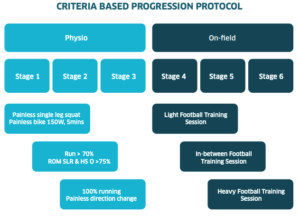
Hamstring injury is a very common injury in a variety of sports, especially those that require high running speeds. It is the most common injury in AFL teams and professional football/soccer with annual I cadence of 4-15%. On average a team suffers 5-6 hamstring Injuries per season which results in a loss of 80 days of sports activities.
The hamstrings are so named because of the way in which European butchers use these muscles to hang the legs of slaughtered pigs to sell. The hamstring tendons are the tendons of the semimembranosus, semitendinosus, and long head of the biceps femoris, they are responsible for hip extension and knee flexion.
Injury can occur anywhere along the length of the musculo-tendinous unit, most injuries occur in the proximal portion. If the tendon is avulsed (pulled off the bone) and retracted surgery is typically necessary in sporting individuals.
Injury occurs during a high speed start, run or kick as the muscle and tendon undergoes a high energy eccentric contraction.
Diagnosis is usually obvious with the grade of injury being confirmed with MRI and ultrasound with X-rays being useful for avulsion injuries.
Important risk factors for injury are player age over 25yrs and history of previous hamstring, quad or calf injury. Hamstring injuries are up to 60% recurrent.
Rehabilitation
The object of a rehabilitation protocol should be to decrease the time to return to sport, returning the athlete to the same level before the injury, without increasing the chance of re-injury. Therefore , the rehabilitation protocol must have criteria to assess when the patient is able to progress to the next phase. Measuring subjective criteria (e.g. pain) and objective criteria (e.g. strength and range of motion) allow the protocol to be adjusted to the athlete and their response to treatment.
Aspetar Protocol
The Aspetar protocol for soccer players is an excellent guide for rehabilitation of hamstring injuries. It consists of 6 stages: 3 for physiotherapy and 3 for returning to the field.
The first stage aims to promote healing of the affected tissue, the second and third stages aim to recover muscle function and neuromuscular control, with the last 3 stages re-integrate the athlete into the sport.

The complete program can be downloaded at www.aspetar.com
